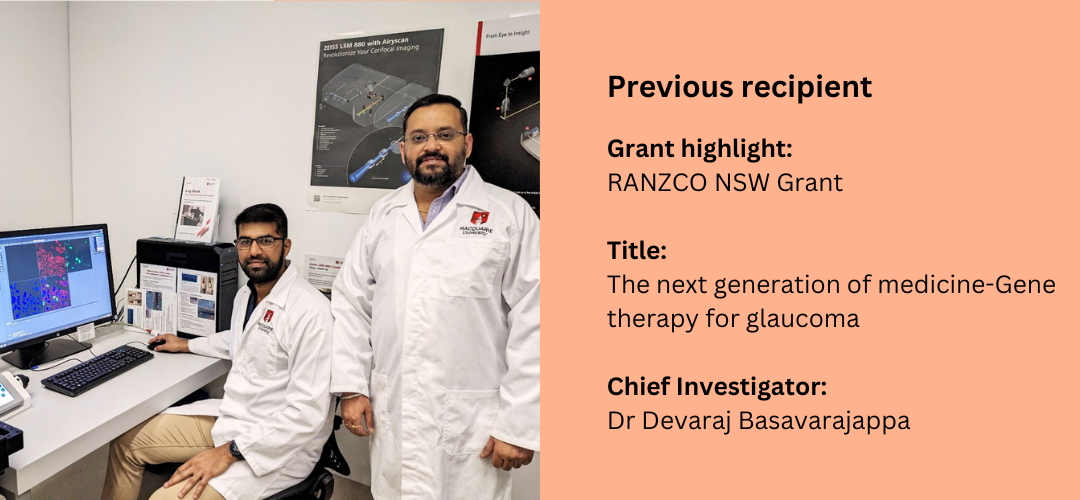Project Title:
The next generation of medicine-Gene therapy for glaucoma
Chief Investigator:
Dr Devaraj Basavarajappa
Co-Investigators:
Aim
To modulate sphingosine-1-phosphate receptor 1 (S1PR1) expression to study the neuroprotection effects of its signalling using gene therapy in a mouse model of glaucoma.
Methods
Modulation of S1PR1 expression in retinal ganglion cells (RGCs) was achieved by viral vector delivery. The effects of S1PR1 modulation were studied through retinal biochemical, structural, and functional analysis in the mice eyes exposed to glaucomatous injury induced by high intraocular pressure (IOP).
Key results
Successful modulation of S1PR1 in the retina was achieved through viral vector delivery. Our results demonstrate that S1PR1 signaling plays a crucial role in protecting RGCs and optic nerve in high IOP-induced glaucoma conditions. Further, modulation of S1PR1 in glaucoma conditions suppressed the neuroinflammatory effects.
Conclusion
This study identified that S1PR1 is a potential neuroprotective therapeutic target and gene therapy-mediated S1PR1 modulation in the retina has positive implications and offers promising strategies to provide neuroprotection in glaucoma and in other CNS injury conditions.
Implications for Clinical Practice/Science and Future Research
The vision loss caused by glaucoma is irreversible, over 300,000 Australians live with glaucoma and almost 10% of the population over 80 years are affected. Current management is limited to lowering the IOP does not prevent the glaucoma progression. Therefore, understanding the molecular basis of disease pathology, in this case, the newly recognized neuroprotective role of S1P receptor modulation, will accelerate breakthrough targeted drug development for neuroprotection in glaucoma.
Publications / Conferences
1. Basavarajappa D, Gupta V, Wall VR, Gupta V, Chitranshi N, Mirshahvaladi SSO, Palanivel V, You Y, Mirzaei M, Klistorner A, and Graham SL (2023). S1PR1 signaling attenuates apoptosis of retinal ganglion cells via modulation of cJun/Bim cascade and Bad phosphorylation in glaucoma. The FASEB Journal 37: e22710. doi:10.1096/fj.20220 1346R
2. Basavarajappa D, Gupta V, Chitranshi N, Wall RV, Rajput R, Pushpitha K, Sharma S, Mirzaei M, Klistorner A, Graham SL (2023). Siponimod exerts neuroprotective effects on the retina and higher visual pathway through neuronal S1PR1 in experimental glaucoma. Neural Regen Res 18(4):840-848. doi: 10.4103/1673-5374.344952.
3. Mirzaei M, Abyadeh M, Turner AJ, Wall RV,. Chick JM, Paulo JA, Gupta VK, Basavarajappa D, Chitranshi S, Mirshahvaladi SSO, You Y, Fitzhenry MJ, Amirkhani A, Haynes PA, Klistorner A, Gupta V, Graham SL (2022). Fingolimod effects on the brain are mediated through biochemical modulation of bioenergetics, autophagy, and neuroinflammatory networks. Proteomics 22(19-20):e2100247. https://doi.org/10.1002/pmic.202100247.
Lay summary of outcomes
Glaucoma is the most common cause of vision loss and despite our best treatments many patients continue to progress. We have identified a novel target protein sphingosine-1- phosphate receptor (S1PR) that plays a key role in glaucoma pathogenesis. Specific modulation of the S1PR1 will provide an innovative therapeutic target for the management of the disease.
This project was sponsored by RANZCO NSW
